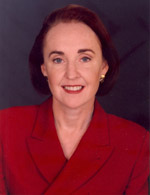Woolley Shows There's a Thirst for Medical Information
By Abhijit Ghosh
A call for increased dialogue between the media and NIH was delivered to attendees at the 20th meeting of the advisory committee on research on women's health, sponsored by the Office of Research on Women's Health recently in Wilson Hall.
Mary Woolley, president of Research!America, presented findings from a 2004 nationwide poll of 1,000 women conducted in collaboration with Parade magazine.
"Research on women's health has never been a higher priority, and there has never been stronger support for research voiced by the American public," she said.
A key finding showed that the public is not aware of where health research is conducted in America. According to Research!America, nearly 95 percent of the American public could not name NIH as the federal agency that funds most medical research paid for by taxpayers.
|
The report also generated insight and opportunities for researchers about public attitudes. For example, most women (82 percent) do not know what causes cervical cancer, thus providing significant opportunities for education. Depression tops the list for potential impact on the quality of women's lives, followed by cancer and heart disease.
In a related note, efforts to raise awareness of heart disease in women show evidence that the campaign has made inroads; 47 percent of women surveyed were aware that heart disease is the leading cause of death for women. Nearly half of the women polled understand that atherosclerosis begins to develop before menopause.
Women, however, have different opinions about the average age at which menopause begins; 38 percent say it starts between ages 46 and 50 while 23 percent think the age is between 41 and 45.
"There is an opportunity here for additional education about this topic," said Woolley.
The poll also provided insight on advocacy and support for research on women's health. Some 81 percent indicated it was "very important" for the U.S. to invest in research designed to improve the health of women. More than half the women said they would be willing to pay $1 more a week in taxes for research that could lead to a cure for human papillomavirus infection and other sexually transmitted diseases. According to Research!America data, less than 1 cent of each U.S. tax dollar is spent on prevention research.
"Stakeholders in research must raise their voices loud and clear in order to be heard," says Woolley.
Up to Top
